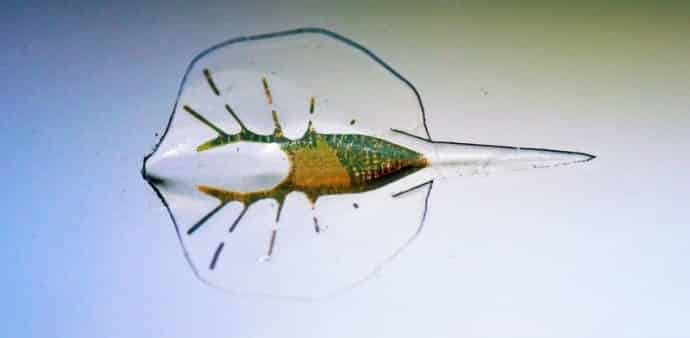Scientists Develop A Light-Guided Cyborg Stingray Powered By Living Rat Cells
An international team of researchers have developed a new kind of synthetic creature, using the heart cells of a rat to make a robotic stingray that follows light. Powered by light-activated heart cells, the cyborg fish could stimulate the development of futuristic medical devices and incredibly life-like synthetic animals.
The ray is the brainchild of Kit Parker, a professor of bioengineering and applied physics from the Wyss Institute at Harvard University, who was motivated to develop the cyborg after visiting the New England Aquarium with his daughter, Caroline.
“She was trying to pet a stingray and she put her hand in the water and the stingray quickly moved away from her hand in a very elegant way,” Parker told Gizmodo. “It struck me like a thunderbolt that I could build that system in the musculature, and that it would look very much like the [muscular] layer of the heart.”
Taking his idea to fellow Wyss researcher Sung-Jin Park, the ambitious project was met with more than a little apprehension at first.
“I sat down with him,” Parker told NPR, “and I said, ‘Sung-Jin, we’re going to take a rat apart; we’re going to rebuild it as a stingray; and then we’re going to use a light to guide it.’ And the look on his face was both sorrow and horror.” But with perseverance, the team succeeded in realising Parker’s vision.
This miniature robot like an actual stingray features a flat body with long wing-like fins. The cyborg stingray, at just 16 millimeters long and weighing 10 grams is only about the size of a small coin, which is made from a gold skeleton covered with a thin layer of stretchy polymer. It is laced with about 200,000 rat heart muscle cells called cardiomyocytes. A series of light-sensitive (photovoltaic) cardiomyocytes were strategically aligned along the top. In the truest sense, the cyborg is a hybrid of biological and synthetic components.
When exposed to light, the muscle cells caused the robot’s fins to contract in a downward motion. When the cells relax, the gold skeleton, which stores some downward energy, pushes the fins back up, resulting in a swimming robot stingray that is guided by a pair of blue lights.
“Optical stimulation induced sequential muscle activation via serpentine-patterned muscle circuits, leading to coordinated adulatory swimming,” the researchers wrote in their study.
“The speed and direction of the ray was controlled by modulating light frequency and by independently eliciting right and left fins, allowing the biohybrid machine to manoeuvre through an obstacle course.”
What is even more impressive is the fact that, depending on the pulse and frequency of light shone at the synthetic creature, its direction and speed can be controlled, allowing it to navigate through the water and around obstacles.
The project, reported in Science, could offer some new leads for roboticists working with soft tissue structures, and also help marine biologists better understand how rays use their fins to swim.
Source: Gizmodo

